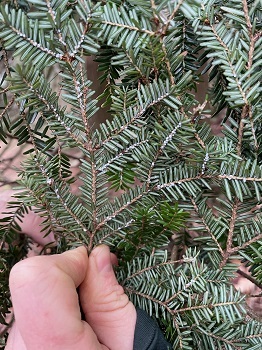|
Feb. 1, 2023
Contact: Rob Miller (MDARD), 517-614-0454, or Joanne Foreman (DNR), 517-284-5814.

A new location of invasive hemlock woolly adelgid has been found in Benzie County, approximately 50 miles north of what was previously thought to be the northern edge of infestation in Mason County, Michigan. Northwest Michigan Invasive Species Network staff members conducting a winter survey for the pest detected the insects on hemlock trees at Crystal Downs Country Club in Frankfort.
The U.S. Department of Agriculture, Animal and Plant Health Inspection Service confirmed a sample taken from the site as positive for hemlock woolly adelgid on Jan. 27.
In 2021, a single tree infested with hemlock woolly adelgid was found at a campsite at the Sleeping Bear Dunes National Lakeshore in Benzie County. The tree’s infested branches were removed, and no signs of the insect have been found in subsequent surveys of the area.
|
Why be concerned?
Hemlock woolly adelgid is a small insect that uses its long, siphoning mouthpart to extract sap from hemlock trees. This feeding weakens needles, shoots and branches. Over time, tree growth slows, and trees take on a grayish-green appearance. Without treatment, infested trees die within four to 10 years.
These insects are considered invasive because they are not native to Michigan and can cause significant harm to the state’s hemlock resource, estimated at 170 million trees.
Surveys aid in early detection
The Northwest Michigan Invasive Species Network is one of four cooperative invasive species management areas, also known as CISMAs, engaged in winter hemlock surveys along the Lake Michigan shoreline. The goal of this widespread effort is to locate new infestations before they spread to unmanageable size.
Crystal Downs Country Club has cooperated with the network for a few years on identifying and managing invasive species on its property. An initial hemlock survey in 2019 did not detect the insect.
“While no one welcomes the news that their trees are infested, we’re glad the survey found the infestation at an early stage so we can contain it and protect hemlock trees, which are an important part of our landscape,” said Crystal Downs Board of Governors President Michael Huget.
Invasive Species Network coordinator Audrey Menninga encourages anyone within 10 miles of the shoreline in Benzie, Grand Traverse, Leelanau and Manistee counties with hemlock trees on their property to request a site visit by completing the online landowner survey form at HabitatMatters.org. Those in other lakeshore counties should contact their local CISMA by visiting MichiganInvasives.org.
Response is underway

With funding from the Michigan Invasive Species Grant Program, the network is now undertaking a delimitation survey of the country club and surrounding properties to determine the extent of the infestation and to mark trees for treatment this summer.
Surveys will continue in other areas of the county and along the lakeshore through March.
The Michigan Department of Agriculture and Rural Development’s hemlock woolly adelgid internal quarantine currently regulates movement of hemlock nursery stock, forest products and yard waste in Allegan, Ottawa, Muskegon, Oceana and Mason counties. Based on the new detection and overall winter survey results, MDARD will determine if an extension of the quarantine to new counties is warranted.
|
How does it spread?
Hemlock woolly adelgid likely arrived in Michigan on infested nursery stock from northeastern states. Though the tiny insects don’t move far on their own, they can be blown by wind or “hitchhike” on birds or mammals that come into contact with an infested branch. In a similar way, cars, boats or recreational vehicles parked under infested trees can transport the insects to new locations.
Help the survey effort

If you are planning to spend time outdoors this winter, help look for and report hemlock woolly adelgid. Look on the undersides of hemlock branches for evidence of round, white ovisacs near the base of the needles.
Up close, ovisacs look like balls of spun cotton and may appear alone or in clusters. The short video “Hemlock Woolly Adelgid: Invasive Species in Michigan” provides helpful identification tips.
Other, less damaging pests easily can be mistaken for hemlock woolly adelgid. Be sure to review photos and descriptions of common hemlock woolly adelgid look-alikes at Michigan.gov/HWA. Help in identifying eastern hemlock trees is available at the same site.
The Northwest Michigan Invasive Species Network is offering hemlock woolly adelgid survey training for the public at no cost on Saturday, March 11, 10-11 a.m. at Almira Township Hall in Lake Ann, Benzie County. Those interested in attending are encouraged to register at HabitatMatters.org/Events.
|
How to report
Trees infested with hemlock woolly adelgid should be reported by one of the following means:
Be prepared to report the location of infested trees and, whenever possible, take one or two pictures of infested branches to help confirm identification. To avoid spreading hemlock woolly adelgid, do not collect sample branches or twigs.
The MISIN smartphone app will take a GPS location point if a report is made at the site; it also will allow you to upload photos with a report.
Michigan's Invasive Species Program is cooperatively implemented by the Michigan Departments of Agriculture and Rural Development; Environment, Great Lakes, and Energy; and Natural Resources.
/Note to editors: Accompanying photos are available below for download. Suggested captions follow.
Benzie branch: Round, white hemlock woolly adelgid ovisacs are found on the undersides of branches near the base of the needles.
Tagging tree: A cooperative invasive species management area staff member tags an infested hemlock tree in a forest.
Magnification: Round, white hemlock woolly adelgid ovisacs are found on the undersides of branches near the base of the needles. Photo courtesy of Lorraine Graney, Bartlett Tree Experts, Bugwood.org./
|